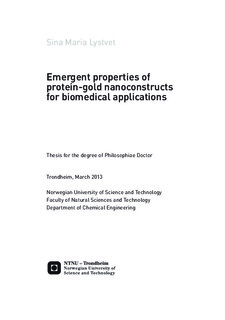| dc.contributor.author | Lystvet, Sina Maria | nb_NO |
| dc.date.accessioned | 2014-12-19T13:27:05Z | |
| dc.date.available | 2014-12-19T13:27:05Z | |
| dc.date.created | 2013-04-02 | nb_NO |
| dc.date.issued | 2013 | nb_NO |
| dc.identifier | 613915 | nb_NO |
| dc.identifier.isbn | 978-82-471-4247-9 (printed version) | nb_NO |
| dc.identifier.isbn | 978-82-471-4248-6 (electronic version) | nb_NO |
| dc.identifier.uri | http://hdl.handle.net/11250/249234 | |
| dc.description.abstract | Bionanomaterials are exciting materials with applications both in diagnostics and treatment of a broad spectrum of diseases. Binding to colloidal structures, such as gold nanoparticles (AuNPs), is known to affect protein conformation. Such alterations in conformation can potentially alter the function and bio-invasiveness of the biopolymer. This implies that a better understanding of the structure/function relationship of proteins can be achieved by deliberately altering protein conformation by modifying them with gold nanoparticles. The acquired protein-gold nanoconstructs may then achieve protein-like properties, gold-like properties, a bit of both, or even brand new properties. A better understanding of the relationship between structure and function for proteins is important because several diseases, such as Alzheimer’s disease, sickle cell anemia, and some types of cancers, are due to errors in protein folding. Lately, the interest for fluorescent proteinstabilized gold nanoclusters (AuNCs) has increased. AuNCs introduce fluorescent probes simultaneously as protein conformation can be altered. Gold nanoconstructs (AuNPs, AuNCs, or mixtures of the two) present the ability to stabilize and study protein folding intermediates that would otherwise be too unstable to study.
In this thesis, several proteins modified by gold-nanoconstructs, such as AuNPs and AuNCs, have been studied. The aim has been to investigate whether it is possible to combine proteins and gold to make new materials with properties not present in either constituent alone. In this thesis such properties are often referred to as "emergent properties". Of the proteins studied, alpha-lactalbumin (aLa) has been the main focus, because of its link to Human Alpha-lactalbumin Made LEthal to Tumor cells (HAMLET), and its bovine analogue BAMLET. Both of which are promising candidates as anti cancer therapeutic agents.
A palette of optical techniques such as UV-vis and fluorescence spectroscopy, ζ- potential measurements, dynamic light scattering, and circular dichroism were used to characterize gold nanoconstructs, protein-gold nanoconstructs and concomitant changes in protein conformation. Additionally, the size of gold nanoconstructs were studied with scanning transmission electron microscopy. Langmuir- and Gibbs monolayers studies,Brewster Angle Microscopy, Digital Video Imaging and Atomic Force Microscopy were used to observe changes in interfacial activity as well as ability to induce film miscibility for the new constructs. Trypan blue assays were used to study the protein-gold nanoconstructs’ ability to induce cell death in cancer cell samples.
The results showed that protein-AuNPs possess membrane affinity properties not seen for any single constituents alone. Bionanomaterials with protein-stabilized AuNCs or AuNPs provide for an inherent optical marker that can be used for imaging and diagnostics. These bionanomaterials also provided a tunability in protein structure, which can be used to understand more about the protein structure/function relationship. Depending on the synthesis-protocol used for the formation of protein-gold nanoconstructs, it was possible to make small (~8 Au atoms, Au8) and large (~25 Au atoms, Au25) protein-stabilized AuNCs, AuNPs stabilized by covalently bound protein-AuNCs, and even to manipulate hydrophobic and hydrophilic properties of the resulting protein-gold nanoconstructs. Langmuir studies of hydrophilic aLa-gold nanoconstructs showed that the protein-gold nanoconstruct induced increased lipid interaction as compared to native aLa. For this reason, cell-viability studies of native bovine aLa, hydrophilic bovine aLa-gold nanoconstructs and BAMLET were compared. The results were very promising as the hydrophilic aLa-gold nanoconstructs showed an ability to kill cancer cells close to the efficiency of BAMLET. | nb_NO |
| dc.language | eng | nb_NO |
| dc.publisher | Norges teknisk-naturvitenskapelige universitet, Fakultet for naturvitenskap og teknologi, Institutt for materialteknologi | nb_NO |
| dc.relation.ispartofseries | Doktoravhandlinger ved NTNU, 1503-8181; 2013:75 | nb_NO |
| dc.relation.haspart | Lystvet, Sina M.; Volden, Sondre; Yasuda, Masahiro; Halskau, Oyvind, Jr.; Glomm, Wilhelm R.. Emergent membrane-affecting properties of BSA-gold nanoparticle constructs. Nanoscale. (ISSN 2040-3364). 3(4): 1788-1797, 2011. <a href='http://dx.doi.org/10.1039/c0nr00948b'>10.1039/c0nr00948b</a>. | nb_NO |
| dc.relation.haspart | Lystvet, Sina M.; Volden, Sondre; Halskau, Oyvind, Jr.; Glomm, Wilhelm R.. Immobilization onto gold nanoparticles alters alpha-lactalbumin interaction with pure and mixed phospholipid monolayers. Soft Matter. (ISSN 1744-683X). 7(24): 11501-11509, 2011. <a href='http://dx.doi.org/10.1039/c1sm06337e'>10.1039/c1sm06337e</a>. | nb_NO |
| dc.relation.haspart | Lystvet, Sina M.; Volden, Sondre; Singh, Gurvinder; Yasuda, Masahiro; Halskau, Oyvind; Glomm, Wilhelm R.. Tunable photophysical properties, conformation and function of nanosized protein-gold constructs. RSC Advances. (ISSN 2046-2069). 3(2): 482-495, 2013. <a href='http://dx.doi.org/10.1039/c2ra22479h'>10.1039/c2ra22479h</a>. | nb_NO |
| dc.relation.haspart | Volden, Sondre; Lystvet, Sina M.; Halskau, Oyvind; Glomm, Wilhelm R.. Generally applicable procedure for in situ formation of fluorescent protein-gold nanoconstructs. RSC Advances. (ISSN 2046-2069). 2(31): 11704-11711, 2012. <a href='http://dx.doi.org/10.1039/c2ra21931j'>10.1039/c2ra21931j</a>. | nb_NO |
| dc.relation.haspart | Lystvet, Sina M.; Volden, Sondre; Singh, Gurvinder; Rundgren, Ida Marie; Wen, Hanzhen; Halskau, Oyvind; Glomm, Wilhelm R.. Anticancer Activity from Gold-alpha-Lactalbumin Nanoconstructs?. The Journal of Physical Chemistry C. (ISSN 1932-7447). 117(5): 2230-2238, 2013. <a href='http://dx.doi.org/10.1021/jp3104886'>10.1021/jp3104886</a>. | nb_NO |
| dc.title | Emergent properties of protein-gold nanoconstructs for biomedical applications | nb_NO |
| dc.type | Doctoral thesis | nb_NO |
| dc.contributor.department | Norges teknisk-naturvitenskapelige universitet, Fakultet for naturvitenskap og teknologi, Institutt for materialteknologi | nb_NO |
| dc.description.degree | PhD i kjemisk prosessteknologi | nb_NO |
| dc.description.degree | PhD in Chemical Engineering | en_GB |

